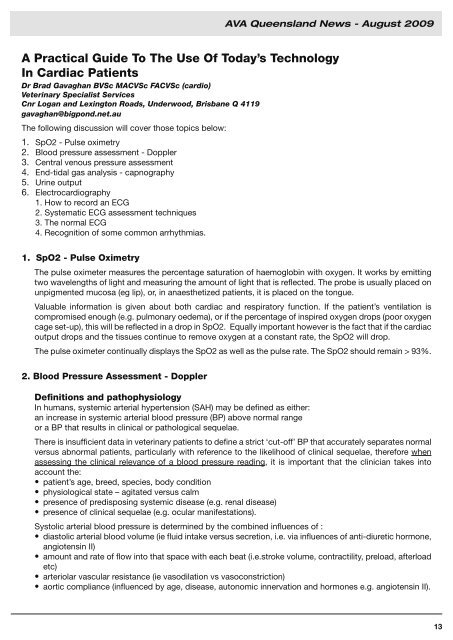Queensland News - Australian Veterinary Association
Queensland News - Australian Veterinary Association
Queensland News - Australian Veterinary Association
- No tags were found...
Create successful ePaper yourself
Turn your PDF publications into a flip-book with our unique Google optimized e-Paper software.
AVA <strong>Queensland</strong> <strong>News</strong> - August 2009A Practical Guide To The Use Of Today’s TechnologyIn Cardiac PatientsDr Brad Gavaghan BVSc MACVSc FACVSc (cardio)<strong>Veterinary</strong> Specialist ServicesCnr Logan and Lexington Roads, Underwood, Brisbane Q 4119gavaghan@bigpond.net.auThe following discussion will cover those topics below:1. SpO2 - Pulse oximetry2. Blood pressure assessment - Doppler3. Central venous pressure assessment4. End-tidal gas analysis - capnography5. Urine output6. Electrocardiography1. How to record an ECG2. Systematic ECG assessment techniques3. The normal ECG4. Recognition of some common arrhythmias.1. SpO2 - Pulse OximetryThe pulse oximeter measures the percentage saturation of haemoglobin with oxygen. It works by emittingtwo wavelengths of light and measuring the amount of light that is reflected. The probe is usually placed onunpigmented mucosa (eg lip), or, in anaesthetized patients, it is placed on the tongue.Valuable information is given about both cardiac and respiratory function. If the patient’s ventilation iscompromised enough (e.g. pulmonary oedema), or if the percentage of inspired oxygen drops (poor oxygencage set-up), this will be reflected in a drop in SpO2. Equally important however is the fact that if the cardiacoutput drops and the tissues continue to remove oxygen at a constant rate, the SpO2 will drop.The pulse oximeter continually displays the SpO2 as well as the pulse rate. The SpO2 should remain > 93%.2. Blood Pressure Assessment - DopplerDefinitions and pathophysiologyIn humans, systemic arterial hypertension (SAH) may be defined as either:an increase in systemic arterial blood pressure (BP) above normal rangeor a BP that results in clinical or pathological sequelae.There is insufficient data in veterinary patients to define a strict ‘cut-off’ BP that accurately separates normalversus abnormal patients, particularly with reference to the likelihood of clinical sequelae, therefore whenassessing the clinical relevance of a blood pressure reading, it is important that the clinician takes intoaccount the:• patient’s age, breed, species, body condition• physiological state – agitated versus calm• presence of predisposing systemic disease (e.g. renal disease)• presence of clinical sequelae (e.g. ocular manifestations).Systolic arterial blood pressure is determined by the combined influences of :• diastolic arterial blood volume (ie fluid intake versus secretion, i.e. via influences of anti-diuretic hormone,angiotensin II)• amount and rate of flow into that space with each beat (i.e.stroke volume, contractility, preload, afterloadetc)• arteriolar vascular resistance (ie vasodilation vs vasoconstriction)• aortic compliance (influenced by age, disease, autonomic innervation and hormones e.g. angiotensin II).13
















